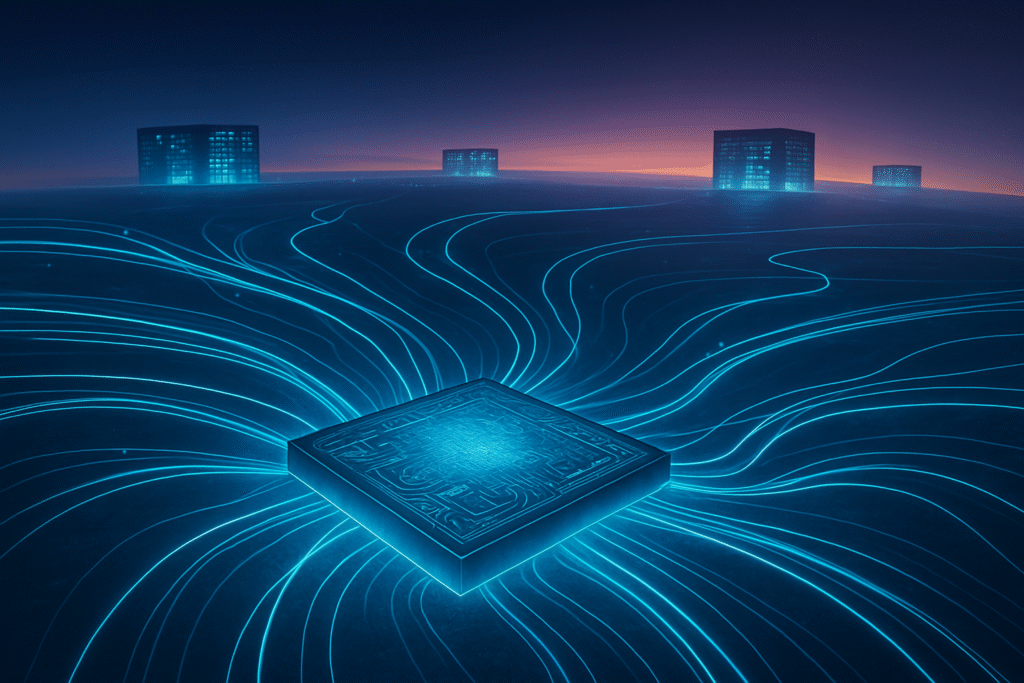
San Jose, CA – October 8, 2025 – In a move set to redefine the architecture of artificial intelligence (AI) infrastructure, Cisco Systems (NASDAQ: CSCO) today announced the launch of its groundbreaking Silicon One P200 chip and the accompanying Cisco 8223 router. This powerful combination is specifically engineered to seamlessly connect geographically dispersed AI data centers, enabling them to operate as a single, unified supercomputer. The announcement marks a pivotal moment for the burgeoning AI industry, addressing critical challenges in scalability, power efficiency, and the sheer computational demands of next-generation AI workloads.
The immediate significance of this development cannot be overstated. As AI models grow exponentially in size and complexity, the ability to distribute training and inference across multiple data centers becomes paramount, especially as companies seek locations with abundant and affordable power. The Silicon One P200 and 8223 router are designed to shatter the limitations of traditional networking, promising to unlock unprecedented levels of performance and efficiency for hyperscalers and enterprises building their AI foundations.
Technical Marvel: Unifying AI Across Vast Distances
The Cisco Silicon One P200 is a cutting-edge deep-buffer routing chip, delivering an astounding 51.2 Terabits per second (Tbps) of routing performance. This single chip consolidates the functionality that previously required 92 separate chips, leading to a remarkable 65% reduction in power consumption compared to existing comparable routers. This efficiency is critical for the energy-intensive nature of AI infrastructure, where power has become a primary constraint on growth.
Powering the new Cisco 8223 routing system, the P200 enables this 3-rack-unit (3RU) fixed Ethernet router to provide 51.2 Tbps of capacity with 64 ports of 800G connectivity. The 8223 is capable of processing over 20 billion packets per second and performing over 430 billion lookups per second. A key differentiator is its support for coherent optics, allowing for long-distance data center interconnect (DCI) and metro applications, extending connectivity up to 1,000 kilometers. This "scale-across" capability is a radical departure from previous approaches that primarily focused on scaling "up" (within a single system) or "out" (within a single data center).
Initial reactions from the AI research community and industry experts have been overwhelmingly positive. Dave Maltz, Corporate Vice President of Azure Networking at Microsoft (NASDAQ: MSFT), affirmed the importance of this innovation, noting, "The increasing scale of the cloud and AI requires faster networks with more buffering to absorb bursts of data." Microsoft and Alibaba (NYSE: BABA) are among the initial customers adopting this new technology. This unified architecture, which simplifies routing and switching functions into a single solution, challenges competitors like Broadcom (NASDAQ: AVGO), which often relies on separate chip families for different network roles. Cisco aims to deliver its technology to customers ahead of Broadcom's Jericho networking chip, emphasizing its integrated security, deep programmability (including P4 support), and superior power efficiency.
Reshaping the AI Industry Landscape
Cisco's Silicon One P200 and 8223 router are poised to significantly impact AI companies, tech giants, and startups alike. Hyperscalers and cloud providers, such as Microsoft Azure and Alibaba, stand to benefit immensely, as their massive AI workloads and distributed data center strategies align perfectly with the P200's capabilities. The ability to seamlessly connect AI clusters hundreds or thousands of miles apart allows these giants to optimize resource utilization, reduce operational costs, and build more resilient AI infrastructures.
The competitive implications are substantial. Cisco's aggressive push directly challenges Broadcom, a major player in AI networking, by offering a unified, power-efficient, and highly scalable alternative. While Broadcom's Jericho chip also targets multi-site AI connectivity, Cisco's Silicon One architecture aims for operational simplicity and a consistent chip family across various network roles. Furthermore, Cisco's strategic partnership with Nvidia (NASDAQ: NVDA), where Cisco Silicon One is integrated into Nvidia's Spectrum-X platform for Ethernet AI networking, solidifies its position and offers an end-to-end Ethernet solution that could disrupt the traditional dominance of InfiniBand in high-performance AI clusters.
This development could lead to a significant disruption of traditional AI networking architectures. The P200's focus on "scale-across" distributed AI workloads challenges older "scale-up" and "scale-out" methodologies. The substantial reduction in power consumption (65% less than prior generations for the 8223) sets a new benchmark for energy efficiency, potentially forcing other networking vendors to accelerate their own efforts in this critical area. Cisco's market positioning is bolstered by its unified architecture, exceptional performance, integrated security features, and strategic partnerships, providing a compelling advantage in the rapidly expanding AI infrastructure market.
A Wider Lens: AI's Networked Future
The launch of the Silicon One P200 and 8223 router fits squarely into the broader AI landscape, addressing several critical trends. The insatiable demand for distributed AI, driven by the exponential growth of AI models, necessitates the very "scale-across" architecture that Cisco is championing. As AI compute requirements outstrip the capacity of even the largest single data centers, the ability to connect facilities across vast geographies becomes a fundamental requirement for continued AI advancement.
This innovation also accelerates the ongoing shift from InfiniBand to Ethernet for AI workloads. While InfiniBand has historically dominated high-performance computing, Ethernet, augmented by technologies like Cisco Silicon One, is proving capable of delivering the low latency and lossless transmission required for AI training at massive scale. The projected growth of Ethernet in AI back-end networks, potentially reaching nearly $80 billion in data center switch sales over the next five years, underscores the significance of this transition.
Impacts on AI development include unmatched performance and scalability, significantly reducing networking bottlenecks that have historically limited the size and complexity of AI models. The integrated security features, including line-rate encryption with post-quantum resilient algorithms, are crucial for protecting sensitive AI workloads and data distributed across various locations. However, potential concerns include vendor lock-in, despite Cisco's support for open-source SONiC, and the inherent complexity of deploying and managing such advanced systems, which may require specialized expertise. Compared to previous networking milestones, which focused on general connectivity and scalability, the P200 and 8223 represent a targeted, purpose-built solution for the unique and extreme demands of the AI era.
The Road Ahead: What's Next for AI Networking
In the near term, the Cisco 8223 router, powered by the P200, is already shipping to initial hyperscalers, validating its immediate readiness for the most demanding AI environments. The focus will be on optimizing these deployments and ensuring seamless integration with existing AI compute infrastructure. Long-term, Cisco envisions Silicon One as a unified networking architecture that will underpin its routing product roadmap for the next decade, providing a future-proof foundation for AI growth and efficiency across various network segments. Its programmability will allow adaptation to new protocols and emerging AI workloads without costly hardware upgrades.
Potential new applications and use cases extend beyond hyperscalers to include robust data center interconnect (DCI) and metro applications, connecting AI clusters across urban and regional distances. The broader Silicon One portfolio is also set to impact service provider access and edge, as well as enterprise and campus environments, all requiring AI-ready networking. Future 5G industrial routers and gateways could also leverage these capabilities for AI at the IoT edge.
However, widespread adoption faces challenges, including persistent security concerns, the prevalence of outdated network infrastructure, and a significant "AI readiness gap" in many organizations. The talent shortage in managing AI-driven networks and the need for real-world validation of performance at scale are also hurdles. Experts predict that network modernization is no longer optional but critical for AI deployment, driving a mandatory shift to "scale-across" architectures. They foresee increased investment in networking, the emergence of AI-driven autonomous networks, intensified competition, and the firm establishment of Ethernet as the preferred foundation for AI networking, eventually leading to standards like "Ultra Ethernet."
A Foundational Leap for the AI Era
Cisco's launch of the Silicon One P200 chip and the 8223 router marks a foundational leap in AI history. By directly addressing the most pressing networking challenges of the AI era—namely, connecting massive, distributed AI data centers with unprecedented performance, power efficiency, and security—Cisco has positioned itself as a critical enabler of future AI innovation. This development is not merely an incremental improvement but a strategic architectural shift that will empower the next generation of AI models and applications.
The long-term impact on the tech industry will be profound, accelerating AI innovation, transforming network engineering roles, and ushering in an era of unprecedented automation and efficiency. For society, this means faster, more reliable, and more secure AI services across all sectors, from healthcare to autonomous systems, and new generative AI capabilities. The environmental benefits of significantly reduced power consumption in AI infrastructure are also a welcome outcome.
In the coming weeks and months, the industry will be closely watching the market adoption of these new solutions by hyperscalers and enterprises. Responses from competitors like Broadcom and Marvell, as well as the continued evolution of Cisco's AI-native security (Hypershield) and AgenticOps initiatives, will be key indicators of the broader trajectory. Cisco's bold move underscores the network's indispensable role as the backbone of the AI revolution, and its impact will undoubtedly ripple across the technological landscape for years to come.
This content is intended for informational purposes only and represents analysis of current AI developments.
TokenRing AI delivers enterprise-grade solutions for multi-agent AI workflow orchestration, AI-powered development tools, and seamless remote collaboration platforms. For more information, visit https://www.tokenring.ai/.






